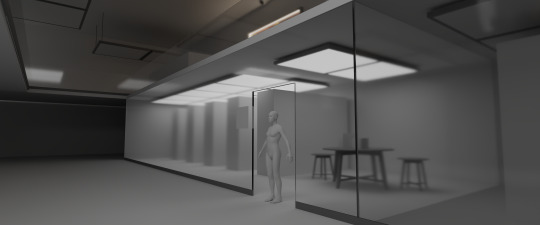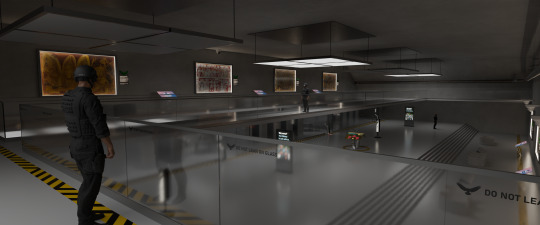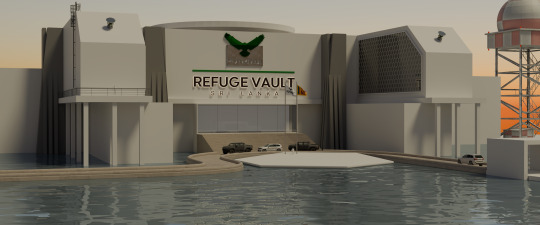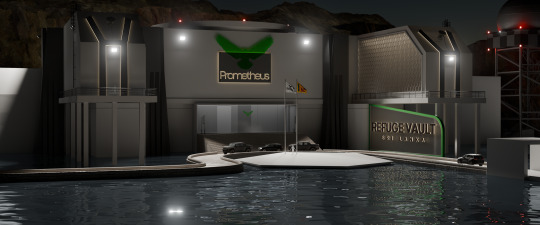Text
Emergency Symbols
1. Biohazard Symbol
- Meaning: Indicates biological risks or hazardous materials, particularly in high-risk areas for pathogen or biological containment.
- Where to use: Near biological containment zones, decontamination showers, and airlock chambers.
2. Radiation Symbol
- Meaning: Warns of potential radiation hazards, signaling areas with radioactive materials or dangerous radiation exposure.
- Where to use: On radiation shielded walls or controlled zones.
3. Chemical Hazard Symbol
- Meaning: Identifies areas containing harmful chemicals or substances that could pose a risk to health.
- Where to use: Near chemical storage areas, spill containment systems, or chemical processing zones.
4. Fire Safety Symbol
- Meaning: Represents fire safety measures and precautions (such as extinguishers, alarms, or gas systems).
- Where to use: Next to gas canisters, fire control systems, and sprinkler-alternating systems.
5. Security Camera Icon
- Meaning: Denotes areas under surveillance, indicating constant monitoring by security systems.
- Where to use: Near high-security zones, access points, or perimeter boundaries.
6. Lock and Key Icon
- Meaning: Represents access restrictions and the need for authorized access, often indicating a biometric scanner or security checkpoint.
- Where to use: On biometric entry systems, secure vaults, or restricted areas.
7. Dangerous Voltage Symbol
- Meaning: Indicates high-voltage equipment or areas at risk of electrical hazards.
- Where to use: Near electrical systems, power failure consoles, or high-energy terminals.
8. No Entry Symbol
- Meaning: Restricts unauthorized personnel from entering specific areas or rooms.
- Where to use: On secure storage areas, archive rooms, or server rooms.
9. Halide Gas Symbol
- Meaning: Indicates areas protected by halide gas systems, typically for fire prevention.
- Where to use: Near gas release canisters, ventilation shafts, or fire protection systems.
10. Exit / Emergency Evacuation Symbol
- Meaning: Shows the route or direction to safety in the event of an emergency or power failure.
- Where to use: Near emergency exits, safe corridors, or evacuation routes.
11. EMP Protection Symbol
- Meaning: Indicates areas or equipment that are protected against electromagnetic pulses (EMP).
- Where to use: On Faraday cages, shielded rooms, or EMP-resistant equipment.

0 notes
Text
Emergency Precautions
Fire Suppression:
No traditional sprinklers. Water damage is unacceptable.
Instead, the vault is flooded with an oxygen-displacing gas (e.g., argon or a futuristic variant) that
Displaces all breathable air within seconds, making it lethal to anyone inside.
Staff receive only a 10-second warning to evacuate to designated safe zones (controlled corridors).
Automated security doors seal the archive rooms to prevent unauthorized emergency access.
Cold, corporate reasoning: "Knowledge is priceless. Lives are replaceable."
Psychological effect: Employees and visitors are reminded that Prometheus' priorities are absolute.
This system visually and thematically reinforces Prometheus’ control, intimidation, and secrecy.
A visitor seeing this system in action (or just learning about it) would immediately understand that this is not a
place built for their comfort or safety—it’s built for preserving and protecting knowledge at all costs.

Halide Gas - Tenet (2020)


Wall mounted gas system (left) | Security Vents (right)
Flood Barriers:

0 notes
Text
First Level - Subdeck
Encrypted Data Streams – Walls or floors subtly pulsing with encoded text moving too fast to be read by the average person, symbolizing constant information processing.
Tactical Maps & Strategic Feeds – Transparent panels showing world events, disasters, or threats, but with parts of the data obscured, suggesting Prometheus controls more than it lets on.
AI Interface Terminals – Stations where personnel can interact with an AI system, but most inputs require clearance beyond that of a standard visitor.
Brutalist Seating (Graphene Infused Concrete)

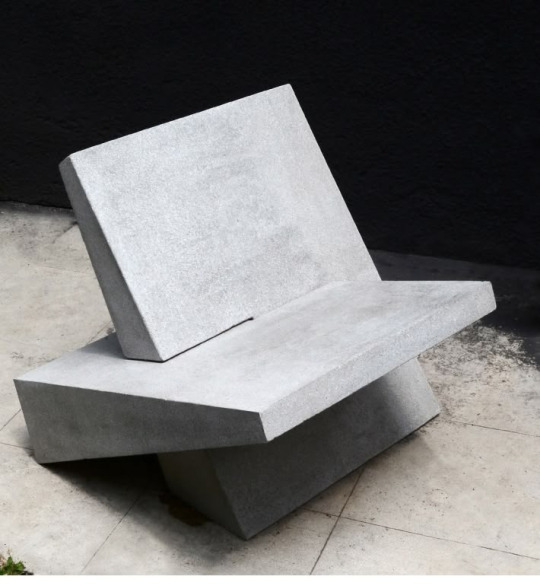


System Terminal (information system)




0 notes
Text
Main Cam - Ground Floor

Restricted Areas & Psychological Barriers
Unmarked, Locked Doors – Silent, dark corridors leading to seemingly nowhere,
Observation Walkways Above – Security personnel or high-ranking members walking
Echoing Footsteps & Dead Silence – Spaces where sound is unnervingly dampened, reinforcing a sterile, controlled environment.
Stanchions


0 notes
Text
Archive Room Design

Biometric Security Terminal




Digital Data Bank

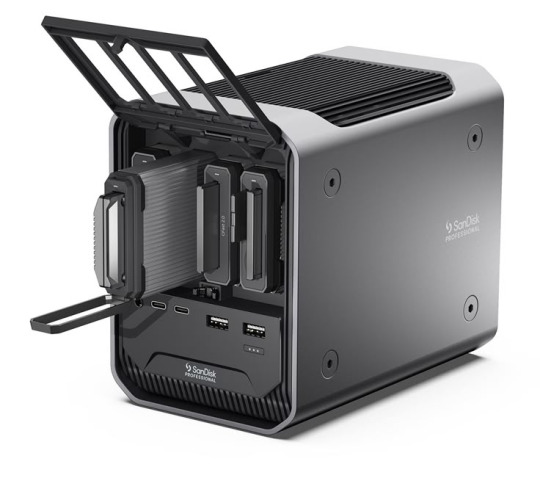


Archive Server
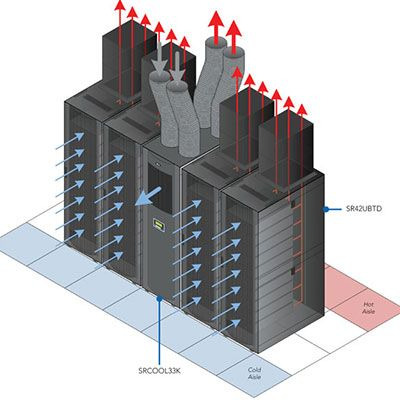
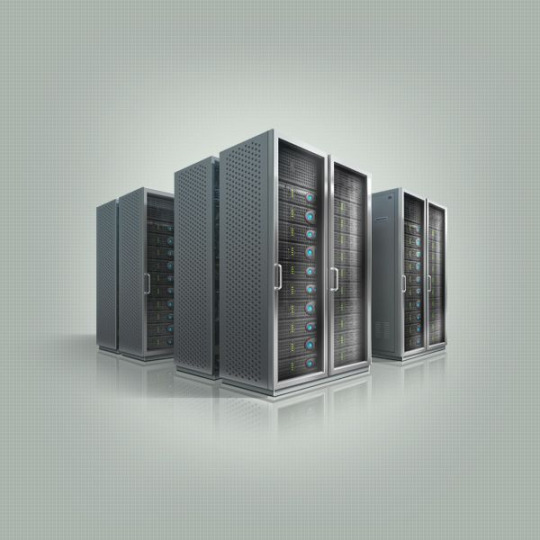
0 notes
Text
World-Building Focus
Prometheus as a Living Entity:
- The vault and its systems are not just visually striking—they represent a larger functioning system with a deep-rooted purpose.
- Every element speaks to a world where knowledge is paramount and human lives are secondary.
Thematic Priorities:
- Control and Secrecy: The vault’s systems and architecture reflect the uncompromising control of Prometheus.
- Survival of Knowledge: Data and information are preserved at all costs, even at the expense of human safety.
- Psychological Impact: The cold, calculated decisions in the design emphasize that Prometheus’ priorities are not about comfort but about preserving what is valuable.
Design as Narrative:
- Every design choice—from security protocols to environmental control systems—tells a story about an organization that values secrecy, power, and control above all else.
- Blurring the Line: Technology and architecture reflect a world where innovation and oppression coexist, creating an atmosphere that is both futuristic and intimidating.
0 notes
Text
Narrative Approach to the Prometheus Vault And What Its About
During my presentation today, one of my lecturers asked about the competition’s goals, which include originality, sustainability, quality of life, environmental impact, utility, and social consideration. Since my submission is heavily focused on world-building and concept development, both visually and narratively, these guidelines are not meant for me to design the Prometheus Vaults for actual, functional use in the real world. Instead, they serve as a social commentary on how large organizations take control during times of uncertainty regarding the fate of entire civilizations.
During my visit to the National History Museum in Colombo, I learned that Dutch colonial powers still possess a significant number of Sri Lankan historical artifacts. Their justification for keeping these artifacts is that Sri Lanka does not have the facilities to preserve them properly, and they believe they can do a better job at safeguarding them than the rightful owners. This power dynamic is central to Prometheus' narrative.
Prometheus operates in a similar way—they enter different countries, construct vaults, and claim to "protect" history, culture, and the defining elements of a nation, ensuring their preservation from any potential harm. However, Prometheus is a cold, calculated organization—they prioritize the artifacts and historical records they protect above all else, including human lives. From their perspective, they believe their cause is noble and that they are fulfilling the competition’s guidelines—but whether their actions are morally justifiable is open to debate.
This project is a narrative and world-building exploration, not a blueprint for a real, functional structure. Therefore, I do not intend to make Prometheus welcoming—because that is not who they are. Prometheus is secretive, cold, and intimidating. Their one true priority is to preserve history at all costs, even if that means disregarding the well-being of the very people responsible for that history.
The technical aspect of my project—designing, modeling, lighting, and rendering the scenes—is what makes it eligible for this specific category in the competition. However, it is the world-building and narrative that truly sets my submission apart from the rest.
Many entries in this category focus solely on technical prowess, showcasing skill in execution without a deeper narrative. My project, however, blends both technical excellence and storytelling, creating something that is not only visually compelling but also thought-provoking.
By integrating a strong conceptual foundation, my submission encourages the audience to engage with the world I’ve built, questioning the fragile debates and ethical dilemmas within it. This fusion of artistic skill and narrative depth ensures that my project is more than just a showcase of technique—it becomes an experience that challenges perception and interpretation.
0 notes
Text
feedback 31st march
under a min to remind of the brief - intro
world building- this is deisgn but also story telling throough design, heavily loading
physical archive, screen and swipe to see more information. physcial interactive elements
glass over the informaiton for the presentation.
washrooms - basic biology, not too humane, time limit, conserving water
0 notes
Text
Interior: Updated designs
Core Themes
✅ Secrecy – Knowledge is restricted, access is controlled. ✅ Surveillance – No movement goes unnoticed. ✅ Intimidation – The environment asserts dominance. ✅ Isolation – Visitors feel small and powerless.
Key Design Elements & Their Impact
Large Glass Walls → Transparency without access. Visitors feel exposed but powerless.
Overhead Security Walkways → Power imbalance. Guards remain above, reinforcing control.
All-Round Surveillance → No place to hide. Large, obvious cameras create unease.
Motion-Activated Lights → The space reacts. Subtle activation delays add tension.
Muted Grey Aesthetic → Cold, corporate, unfeeling. No comfort, only function.
Brutalist Design & Materials ��� Unyielding and impersonal. Concrete, stone, and rubber reinforce authority.
Technical System Terminals → Complexity as a barrier. Information is present but inaccessible.
Every element is designed to make Prometheus feel like more than a facility—it’s a force that watches, controls, and decides.

Main Camera: Ground Level

Archive Room: First Level

Secondary Camera: First Level - Subdeck
0 notes
Text
The Corporate Dread of Lumon Industries (Severance) — And How It Inspires Prometheus
What is Severance?
For those unfamiliar, Severance is a psychological thriller series that explores the eerie concept of work-life balance taken to the extreme. Employees of Lumon Industries undergo a procedure called "severance," which surgically splits their consciousness into two distinct identities: their "innie" (work self) and "outie" (personal self). The innie only exists within the office, knowing nothing of the outside world, while the outie remains oblivious to what happens at work. This creates a haunting corporate dystopia where employees are trapped in an endless cycle of work, completely disconnected from their own lives outside.
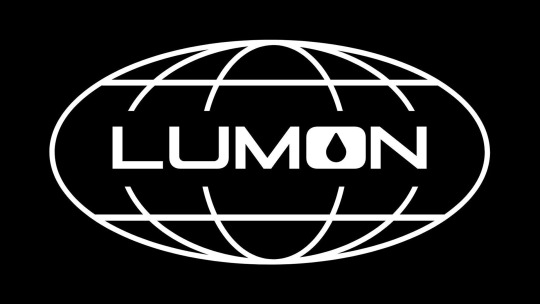

Lumon Industries is more than just a company—it’s an omnipresent force, a machine that swallows people whole. It’s sterile yet unnerving, cold yet cult-like, efficient yet deeply unsettling. Lumon operates under a veil of secrecy, its halls stretching endlessly, its employees trapped in a cycle of work they don’t even remember choosing.

There’s something terrifyingly fascinating about a corporation that feels larger than life, one where the walls seem to whisper, where the structure itself is as much a character as the people inside. It’s not just the endless corridors or the emotionless work routines that make Lumon unsettling—it’s the feeling that this company doesn’t just exist in the world. It is the world, at least for those inside it.
And that’s exactly the energy I want to bring into Prometheus.
The Aesthetic of Corporate Control
Prometheus, on the surface, is an organization dedicated to preserving what remains. A noble cause. But like any entity that deals with power—especially the power of knowledge, of survival—it must operate with a certain level of secrecy. The world outside is collapsing, and Prometheus positions itself as the last bastion of preservation, a final archive for the remnants of civilization. But at what cost?

I want Prometheus to feel monolithic. An institution that is too big to question, too advanced to grasp fully. It doesn’t advertise itself; it doesn’t need to. It exists in sleek, windowless facilities that hum with unseen activity, its employees functioning as cogs in a grander, unknowable mechanism. Their work is vital, but not personal. The people within are replaceable, but the mission is eternal.
Like Lumon, Prometheus is a place where the environment is designed to make you feel small. Hallways that stretch just a little too long. Doors that seal a little too quietly. Screens that never turn off, always displaying data that no one seems to question. It’s a company that isn’t just housing the future—it’s dictating it.
The Fear of Purpose Without Choice
One of the most terrifying aspects of Lumon is how it strips people of their autonomy while convincing them they are part of something bigger. Prometheus operates under a similar philosophy. To the outside world, it is salvation. To those inside, it is routine, structure, the quiet hum of something beyond human comprehension. It is not a prison, but it is not freedom either. It is duty. It is the weight of responsibility, of knowing that if you walk away, there may be nothing left.

Prometheus is not evil. It is not good. It is necessary. And that’s what makes it terrifying.
This is the energy I want to bring to my competition project. Not just a world that looks futuristic, but one that feels overwhelming. Not just a corporation, but an institution. A presence. A quiet, calculated force that stands between oblivion and a carefully curated future.
A world where humanity is preserved—but at a cost that no one is allowed to discuss.
0 notes









